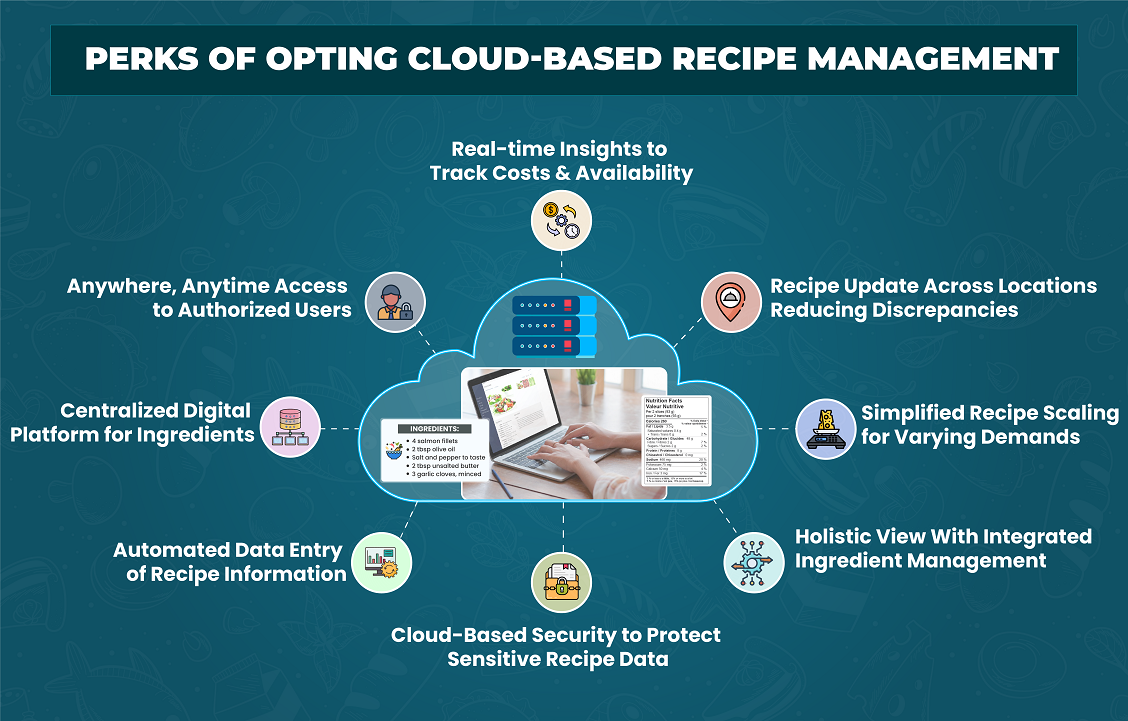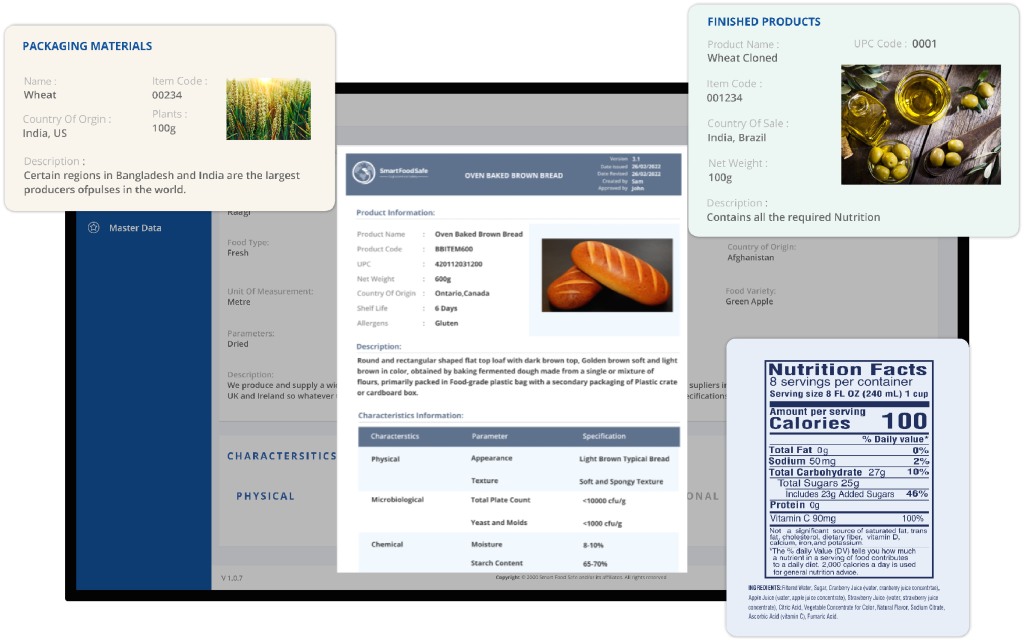
When customers find a dish they love at a restaurant, they expect it to taste the same every time they order it. Any unmentioned alterations to the recipe—whether intentional or accidental—can lead to disappointment. A research study revealed that dissatisfied customers tend to share their negative experiences with 9-15 people, and over one in ten will spread the word to as many as 20, significantly impacting a restaurant’s reputation and customer retention.
To maintain consistency and keep customers satisfied, effective recipe management is crucial for controlling costs and sustaining a profitable menu. However, the traditional methods of recipe management, which have been predominantly manual, present various challenges. This is where cloud-based recipe management emerges as an ideal solution to offer a more efficient, accurate, and centralized tool in this scenario.
Let’s explore the transition from the conventional mode of recipe management to the new era of digital solutions, highlighting the benefits, challenges, and features to consider when adopting modern recipe management systems.
What is Recipe Management?
Recipe management is the systematic process of documenting and organizing the information needed to produce a dish or food product. This includes the specific ingredients, formulas, procedures, and equipment involved in creating the product. The process ensures that the recipe is consistently followed, regardless of who is preparing the dish or the location where it’s being prepared.
In today’s digital age, any negative feedback from an unhappy customer can be amplified through social media and review platforms, adversely affecting foodenterprises’s brand position. Consistent recipe management helps ensure that each dish tastes the same every time, fostering customer loyalty and repeat business. Thorough recipe management enables restaurants and food manufacturers to maintain quality, control costs, and scale production seamlessly. It also plays a vital role in ensuring compliance with food safety standards and regulations.
Challenges of Traditional Recipe Management
Despite its importance, traditional recipe management methods present challenges, particularly when done manually. Here are some of the key hurdles:
- Manual Data Entry and Paper Invoices – Many restaurants still rely on paper invoices and manual data entry to track recipe costs. This approach is time-consuming and error-prone. Invoices can easily get lost or damaged in a busy kitchen environment, making it difficult to keep track of ingredient prices. Even with a reliable system for storing invoices, manually processing them can be tedious and costly.
- Time Constraints – The food industry is fast-paced, with restaurant managers, chefs, and staff juggling numerous tasks during service. Finding the time to focus on detailed recipe management can be a struggle. For upper-level staff who need to oversee both the front and back of the house, allocating time for recipe calculations and updates often takes a back seat to immediate operational needs.
- Complexity of Recipe Calculations – Correctly calculating the cost of each recipe involves tracking ingredient costs, adjusting for yields, and converting units of measurement. This can be particularly challenging when scaling recipes up or down for different serving sizes. Manual methods like spreadsheets can quickly become cumbersome, with significant room for human error. As a result, many operators only calculate recipe costs once or settle for outdated numbers.
- Difficulty in Maintaining Recipe Version Control – Recipes often need to be updated as ingredient availability changes or improvements are made. Manually tracking different versions of a recipe increases the risk of using outdated versions, leading to inconsistencies in production.
Emergence of Cloud-Based Recipe Management as a Solution
Cloud-based recipe management software is a digital solution designed to automate and simplify the process of managing recipes. It stores all recipe-related information in a centralized digital platform, making it easily accessible to authorized users from anywhere with an internet connection. This software helps automate data entry and can be integrated with other systems like inventory management and point-of-sale (POS) systems, and provides real-time insights into recipe costs and ingredient availability. Here’s how cloud-based solutions address the challenges of traditional recipe management as well as the advantages it brings forth:
- Enhanced Data Accuracy through Automation – Cloud-based recipe management software reduces the need for manual data entry by automating the process of capturing and updating ingredient costs. This minimizes human error and ensures precise calculations. It can automatically adjust for fluctuations in ingredient prices, providing up-to-date information that helps operators make informed decisions about pricing and profitability.
- Accessibility and Real-Time Updates – One of the significant advantages of cloud-based systems is that they can be accessed from anywhere, anytime. This allows managers and chefs to update recipes, adjust costs, and ensure consistency across multiple locations. Real-time updates ensure that everyone is working with the latest version of a recipe, reducing the risk of inconsistencies.
- Simplifying Recipe Scaling and Cost Calculations – Cloud-based software simplifies the process of scaling recipes for different batch sizes, making it easier to adapt to changes in demand. It automatically calculates ingredient quantities, labor costs, and other factors, ensuring that scaling up or down does not compromise quality or profitability. For instance, if a restaurant needs to scale a recipe for a larger event or special promotion, the software can adjust the ingredients and costs accordingly with minimal margin for error.
- Seamless Integration with Other Systems – Many cloud-based recipe management solutions offer integration with the enterprise’s existing systems. This allows restaurant operators to have a holistic view of their operations, from inventory levels to sales data, making it easier to track costs and revenues. For example, when inventory levels are low, the system can alert managers to reorder ingredients, ensuring smooth operations.
- Improved Training and Onboarding – Recipe management software can serve as a training tool for new employees, helping them understand the specific steps required to prepare each dish. This makes the onboarding process more efficient and ensures that new staff members quickly become familiar with the standards of the restaurant.
- Enhanced Cost Control and Profitability – Cloud-based solutions provide real-time visibility into ingredient costs, allowing restaurant operators to adjust menu prices and ingredient choices as needed. This is particularly valuable in times of ingredient price volatility, as it enables businesses to maintain profitability without compromising on quality.
- Scalability – As businesses grow, so do their production requirements. Cloud-based systems are designed to scale with the business, accommodating increased recipe complexity, larger production volumes, and additional locations without sacrificing efficiency.
- Efficient Data Security – By storing recipes and related data in the cloud, businesses can protect sensitive information from loss or damage. Cloud-based solutions offer controlled access, ensuring that only authorized personnel can view or edit recipes, protecting trade secrets and intellectual property.
Key Considerations When Choosing Recipe Management Software
Selecting the right cloud-based recipe management software for your business is essential for maximizing its benefits. Here are some factors to consider when making your choice:
- Focus on Data Accuracy – Look for software that automates data entry and integrates with invoice processing systems. This ensures that the cost data used in recipe calculations is always accurate, helping you maintain a true picture of profitability.
- Support for Multiple Units of Measurement (UoM) – Your software should be flexible in recognizing and converting various units of measurement. For example, it should handle conversions between pounds and cups easily, making it easier for chefs to prepare recipes accurately.
- Integration Capabilities – Consider whether the software can integrate with your existing production-related systems. Integration enables a streamlined flow of information across different aspects of your operations, providing a comprehensive overview of your business.
- User-Friendly Interface – A user-friendly interface is crucial for ensuring that your team can easily adopt the software. It should be intuitive and easy to navigate, reducing the learning curve and boosting productivity.
- Scalability for Business Growth – Choose a solution that can grow with your business. As your restaurant or food production facility expands, you’ll need software that can handle increased recipe complexity and production volumes.
- Focus on Food Safety Compliance – Compliance with food safety regulations is non-negotiable. Ensure that your recipe management software allows you to track allergens, additives, and other critical information that impacts food safety and compliance.
In short, cloud-based recipe management software offers a powerful way to maintain consistency, manage costs, and scale operations, all while ensuring compliance with food safety standards. With the right software, food businesses can overcome the challenges of manual recipe management and deliver a consistently great experience to their customers. As the industry continues to evolve, those who embrace the new era of cloud-based recipe management will be well-positioned to thrive in an increasingly competitive market.
Smart Specification as your Partner for Effective Recipe Management
Smart Specification comes forward as a specification management software with the ability to create, store, and track material specifications including ingredients, allergens, nutritional values, packaging, and manufacturing processes. By integrating features like version control, audit logs, document collaboration, and supplier management, it helps to keep the recipe standardized throughout product development and quality control processes.
Smart Specification ensures that you remain compliant with regulatory requirements and industry standards, while also supporting the precise scaling of recipes that cloud-based solutions make possible. By streamlining workflows and reducing errors, it enables smooth communication across teams, facilitating a collaborative approach to managing recipes. Whether you’re scaling a new dish or adapting to ingredient price changes, Smart Specification empowers you to deliver safe, high-quality products consistently to the market—meeting both business goals and customer expectations in the modern era of cloud-based recipe management.





